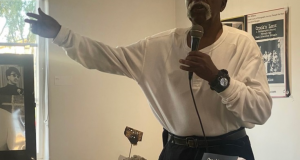By Pilar Marrero
Many are vowing to continue the fight to protect diversity in higher education and warn policy makers and educators not to overreach in interpreting the controversial ruling.
Civil rights leaders joined together to denounce last week’s Supreme Court decision ending Affirmative Action. Many are warning of the negative effects the ruling will have on students of color.
“Race is still relevant, racial discrimination is still relevant,” said Thomas A. Saenz, President and General Counsel of the Mexican American Legal Defense and Education Fund (MALDEF).
Saenz pointed to the majority opinion written by Chief Justice John Roberts, which states that college admission programs can consider how race has affected an applicant’s character specifically, but that race cannot be a general consideration in admissions.
“That is a clear indication that this is not a mandate or even an invitation to ignore race in the context of higher education,” explained Saenz in an interview with Ethnic Media Services.
The June 29 decision overturned 45 years of precedent by ruling that Affirmative Action policies violate the Equal Protection Clause of the Constitution.
Saenz and others warned policymakers and higher education leaders not to overreach in their interpretation of the ruling. They also urged students of color not to “adjust their ambitions in any way” because of this decision.
“That is a clear indication that this is not a mandate or even an invitation to ignore race in the context of higher education,” explained Saenz in an interview with Ethnic Media Services.
The June 29 decision overturned 45 years of precedent by ruling that Affirmative Action policies violate the Equal Protection Clause of the Constitution.
Saenz and others warned policymakers and higher education leaders not to overreach in their interpretation of the ruling. They also urged students of color not to “adjust their ambitions in any way” because of this decision.
“Policymakers cannot use this decision as some excuse to ignore racial disparity or to ignore the imperative to address it,” said Saenz. “This doesn’t change regulations under the Federal Civil Rights Act of 1964.”
Thomas A. Saenz, President and General Counsel of the Mexican American Legal Defense and Educational Fund (MALDEF), notes that race can still be taken into account for college admissions, as it relates to an applicant’s life experience.
Racial gaslighting
Colleges and universities across the country – particularly those states where, before this decision, race was still used as part of the criteria in college and university admissions – should evaluate their practices for equity, said leaders in the higher education access arena.
“We know that Affirmative Action was one of the best tools to ensure there was a diverse student body,” said Michelle Siqueiros, President of the Campaign for College Opportunity. “SCOTUS should have also banned legacy (admissions), which makes up more than a quarter to a third of the class at some selective institutions, including Harvard.”
She added the practice of granting admission to the sons and daughters of alumni, along with early decision admissions and the extensive use of standardized tests, “do not expand opportunities to low-income Black, Latino and Asian American Students.”
Several groups in Boston filed a complaint with the Education Department on Monday requesting that it review the practice of legacy admissions, arguing it discriminates against students of color by favoring the children of alumni at elite schools, most of whom are white.
Author and education scholar J. Luke Wood described the ruling as “racial gaslighting at its best.” Wood is the incoming president at Sacramento State University.
“If they are concerned about discrimination, they should move away from standardized testing, which is a better indication about a student’s resources” and not his or her capacities. “This will definitely have an impact on access to colleges and universities by students of color,” said Wood.
Sending a message to students of color
Marita Etcubañez, Vice President of Strategic Initiatives with Asian Americans Advancing Justice (AAJC), discusses the Asian American response to the ban on affirmative action and notes that Asian Americans did not initiate the lawsuit, nor were there any student plaintiffs in the case.
All of those interviewed said they worried about students getting the wrong message from the ruling and the impact this could have on students of color already in higher education institutions.
“We want to make sure that students of color know that they still belong, that we will be fighting for you, and we encourage you to apply to the school of your choice, don’t be scared off by this opinion,” said Marita Etcubañez, Vice President of Strategic Initiatives with Asian Americans Advancing Justice (AAJC).
Etcubañez, like other Asian American civil rights leaders, also expressed concerns about arguments that Affirmative Action policies unfairly discriminated against Asian students. “This is simply false,” she said.
“The District Court examined all the evidence and found no evidence to support the claim that there was discrimination against Asian Americans,” said Etcubañez. “I also want to make sure people know that Asian Americans were not behind this case.”
In fact, the case was brought forward by a group called Students for Fair Admissions led by conservative activist Ed Blum, who Etcubañez noted “has engaged in a campaign to systematically take down Affirmative Action for years. This was not an organic case to right a wrong.”
Blum is a Republican financier who was also behind the 2013 Shelby v. Holder decision, which gutted Section 5 of the Voting Rights Act, eliminating the requirement that states with a history of racial discrimination targeting voters of color seek federal preclearance for any changes to their election laws.
In a scathing dissent to the majority’s ruling, Justice Sonia Sotomayor wrote: “The three Justices of color on this Court graduated from elite universities and law schools with race-conscious admissions programs, and achieved successful legal careers, despite having different educational backgrounds than their peers.”
In her opinion, Justice Ketanji Brown Jackson, who joined Sotomayor in her dissent, offered a fiery exchange with conservative justice Clarence Thomas, who is also African American and leads the ultra-conservative wing of the court.
‘We will be watching’
Michele Siqueiros, President of The Campaign for College Opportunity, says affirmative action advocates will continue to fight for fair admissions to colleges and to ensure that campuses remain diverse.
“Thomas went to Yale Law School, my alma mater, at a time when almost certainly the law school was using an Affirmative Action system that benefited him,” said Saenz from MALDEF. “This indicates how much of a limitation this could be for our future. Future justices, future leaders, elected leaders, and future professionals will be diminished in their ranks by the court’s wrongheaded decision.”
Michelle Siqueiros, President of the Campaign for College Opportunity, said that her organization and many others would fight to counteract the effects of this ruling as they have done in California and other states where local laws limited the use of race in admissions over the years.
“We won’t accept a return to the 1940s and 1950s when colleges blatantly discriminated against women, African Americans, Jewish Americans, Latinos, and Indigenous folks at their campuses,” said Siqueiros.
“We will be watching,” she added, noting that at a time when more than 50% of students in K-12 schools are students of color, “we are hopeful that college leaders know and support and value providing opportunity for all Americans.”
 Westside Story Newspaper – Online The News of The Empire – Sharing the Quest for Excellence
Westside Story Newspaper – Online The News of The Empire – Sharing the Quest for Excellence





